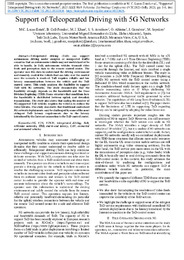Por favor, use este identificador para citar o enlazar este ítem:
https://hdl.handle.net/11000/33029Registro completo de metadatos
| Campo DC | Valor | Lengua/Idioma |
|---|---|---|
| dc.contributor.author | Lucas-Estañ, M. Carmen | - |
| dc.contributor.author | Coll-Perales, Baldomero | - |
| dc.contributor.author | M. I., Khan | - |
| dc.contributor.author | Avedisov, S. | - |
| dc.contributor.author | Altintas, Ozcan | - |
| dc.contributor.author | Gozalvez, J. | - |
| dc.contributor.author | Sepulcre, Miguel | - |
| dc.contributor.other | Departamentos de la UMH::Ingeniería de Comunicaciones | es_ES |
| dc.date.accessioned | 2024-09-09T10:32:27Z | - |
| dc.date.available | 2024-09-09T10:32:27Z | - |
| dc.date.created | 2023 | - |
| dc.identifier.citation | 2023 IEEE 98th Vehicular Technology Conference (VTC2023-Fall), 2023, pp. 1-5 | es_ES |
| dc.identifier.uri | https://hdl.handle.net/11000/33029 | - |
| dc.description.abstract | Teleoperated driving (ToD) can support autonomous driving under complex or unexpected traffic scenarios that an autonomous vehicle may not understand or be able to handle. In ToD, autonomous vehicles transmit video feeds and perception data to the remote control center. The operator uses this data to understand the driving environment and remotely control the vehicle that can take over the control once the scenario is resolved. ToD requires reliable and low latency communications between the vehicle and the ToD control center. This study analyzes the feasibility to support ToD with 5G networks. The study demonstrates that the feasibility strongly depends on the bandwidth and the Time Division Duplexing (TDD) frame structure that conditions how the bandwidth is distributed between uplink and downlink transmissions. The study also shows that scaling the number of 5G-supported ToD vehicles requires the vehicles to reduce the video bitrates. The study also shows that traditional centralized 5G network deployments may be challenged by some of the most stringent ToD latency requirements due to the latency introduced by the Internet connection to the ToD c | es_ES |
| dc.format | application/pdf | es_ES |
| dc.format.extent | 6 | es_ES |
| dc.language.iso | eng | es_ES |
| dc.publisher | IEEE | es_ES |
| dc.relation.ispartof | 2023 IEEE 98th Vehicular Technology Conference (VTC2023-Fall), 2023, pp. 1-5 | es_ES |
| dc.rights | info:eu-repo/semantics/openAccess | es_ES |
| dc.rights.uri | http://creativecommons.org/licenses/by-nc-nd/4.0/ | * |
| dc.subject | 5G | es_ES |
| dc.subject | V2N | es_ES |
| dc.subject | V2NV2 | es_ES |
| dc.subject | teleoperated driving | es_ES |
| dc.subject | ToD | es_ES |
| dc.subject | vehicular networks | es_ES |
| dc.subject | TDD | es_ES |
| dc.subject | end-to-end latency | es_ES |
| dc.subject | CAV | es_ES |
| dc.subject | connected and automated vehicles | es_ES |
| dc.subject.other | CDU::6 - Ciencias aplicadas::62 - Ingeniería. Tecnología | es_ES |
| dc.title | Support of Teleoperated Driving with 5G Networks | es_ES |
| dc.type | info:eu-repo/semantics/article | es_ES |
| dc.relation.publisherversion | https://doi.org/10.1109/VTC2023-Fall60731.2023.10333656 | es_ES |

Ver/Abrir:
Support of Teleoperated Driving with 5G Networks.pdf
PrePrint
405,45 kB
Adobe PDF
Compartir:
 La licencia se describe como: Atribución-NonComercial-NoDerivada 4.0 Internacional.
La licencia se describe como: Atribución-NonComercial-NoDerivada 4.0 Internacional.
.png)